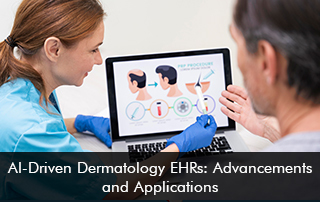Digital health records (EHRs) that incorporate artificial intelligence (AI) have given dermatology clinics new opportunities. Machine learning algorithms and computer vision techniques are used by AI-driven Dermatological EHRs to evaluate medical pictures, aid in early diagnosis, and offer individualized therapy suggestions. This article will examine the most recent developments and numerous applications of AI in dermatological EHRs, emphasizing how this game-changing technology is transforming the discipline of dermatology.
Understanding AI in Dermatology EHRs:
In dermatology, artificial intelligence to assess and interpret skin diseases, EHRs refers to the use of computer vision, deep learning, and machine learning algorithms. These AI-powered EHRs can process a sizable quantity of dermatological data, including pictures, medical records, and pathology reports, to offer doctors insightful analysis and suggestions.
Advancements in AI-Driven Dermatology EHRs:
-
Sophisticated Image Recognition:
- Dermatology powered by AI EHRs are excellent at identifying and analyzing images.
- These systems are a useful tool for dermatologists in generating correct diagnoses since they can reliably recognize and categorize skin lesions, moles, rashes, and other dermatological traits from medical photographs.
-
Automated Diagnosis:
- AI-powered dermatological EHRs may do automated diagnosis and differential diagnosis by examining past patient data.
- They can also identify potential skin disorders based on comparable instances from a large database, assisting dermatologists in making quicker and more accurate diagnoses.
-
Differential Diagnosis Support:
- Dermatology powered by AI EHRs use patient data and the most recent research in medicine to offer individualized treatment recommendations.
- Based on the patient’s unique condition and medical history, these systems can recommend the best course of treatment, including drugs, topical creams, and other therapies.
4. Personalized Treatment Recommendations:
- AI-driven EHRs make individualized treatment recommendations by using patient-specific data and the most recent scientific research, which improves patient outcomes.
5. Early Detection of Skin Cancer:
- The early diagnosis of skin cancer is one of the most important uses of AI in dermatological EHRs.
- Skin lesion photos can be analyzed by AI algorithms to identify worrisome situations that may call for additional testing or biopsies.
- The odds of a favorable outcome from treatment can be greatly improved by this early discovery.
6. Tele-Dermatology Efficiency:
- Dermatology powered by AI EHRs have been extremely useful in tele-dermatology.
- These systems enable dermatologists to deliver consultations and diagnosis without the need for in-person visits by accurately analyzing patient photos remotely.
7. Workflow Optimization:
- AI-driven EHRs shorten the documentation process and enhance the overall workflow in dermatology practices by automating image analysis and diagnosis.
- With the knowledge that AI is effectively handling picture interpretation and analysis, dermatologists may concentrate more on patient care and treatment planning.
8. Enhanced Dermatological Research:
- Dermatology using AI EHRs facilitate population-based studies, evaluate aggregated patient data, spot trends, and provide large-scale data analysis, all of which help dermatological researchers better understand skin problems and potential treatments.
Applications of AI-Driven Dermatology EHRs:
-
Precision Diagnoses:
AI systems ensure accurate diagnoses, minimizing diagnostic blunders and improving the precision of treatment regimens.
2. Virtual Consultations:
AI-driven EHRs provide remote consultations, making dermatological knowledge more accessible to all people, no matter where they are in the world.
3. Efficient Triage of Cases:
Prioritizing urgent cases with AI’s help ensures that patients with potentially dangerous diseases receive prompt care.
4. Customized Treatment Plans:
Individualized therapy suggestions improving patient care by adjusting therapy to each patient’s needs.
5. Education and Training:
AI-powered EHRs aid in medical education and training, providing valuable insights and case-based learning opportunities.
6. Data-Driven Insights:
AI-powered data analysis on a large scale advances medical knowledge and allows for a better understanding of dermatological disorders.
7. Elevating Patient Experience:
Early detection, accurate diagnosis, and tailored treatments improve patient satisfaction and outcomes.
Challenges and Future Directions:
- Despite the enormous potential of AI-driven dermatology EHRs, issues including data privacy, algorithm bias, and integration with current EHR systems must be resolved.
- With breakthroughs in deep learning models, data sharing partnerships, and real-time updates, the future of AI in dermatology holds promise.
The integration of artificial intelligence (AI) in electronic health records (EHRs) is one area that has transformed patient care and diagnosis in the field of dermatology in recent years. Dermatologists’ ability to assess skin diseases, provide precise diagnoses, and suggest individualized treatment strategies is changing as a result of AI-driven dermatology EHRs. This blog will explore the most recent developments and uses of AI in dermatology EHRs, examining how this technology is improving the accuracy, effectiveness, and general standard of dermatological care.






